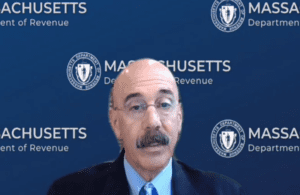Who is a member?
Our members are the local governments of Massachusetts and their elected and appointed leadership.

Revenue Commissioner Geoffrey Snyder discussed tax collection projections during the annual Consensus Revenue Hearing on Dec. 21.
Despite a persistent public health emergency, the Commonwealth’s fiscal outlook for the remainder of fiscal 2022 and looking ahead to fiscal 2023 remains strong, but not without some uncertainty.
Tax collections far exceeded benchmarks in fiscal 2021, leading to a substantial state surplus, and they are on track to do the same in fiscal 2022.
Still, during the annual Consensus Revenue Hearing convened today by the House and Senate Ways and Means committees and the governor’s budget office, the Department of Revenue and other fiscal experts and economists offered cautious outlooks for the economy and state revenues over the second half of fiscal 2022 and for fiscal 2023.
For the current fiscal year, the Department of Revenue projects total tax collections to be in the range of $35.7 billion to $36.6 billion, or approximately $6 billion higher than last year’s $30.1 billion consensus revenue figure that was used to build the governor’s fiscal 2022 budget. Revenue Commissioner Geoffrey Snyder said the current projection represents an increase of between $1.3 billion and $2.2 billion over the revised fiscal 2022 benchmark set by Administration and Finance Secretary Michael Heffernan on Aug. 27.
For fiscal 2023, the Department of Revenue forecasts a tax collection range of $36.5 billion to $37.7 billion, representing an increase of 2.1% to 2.9% over the revised fiscal 2022 forecast.
The outlooks presented for next year at the hearing were all heavily qualified with discussions of uncertainty due to the ongoing public health emergency, global supply chain issues and labor shortages, inflation, interest rates, and other factors.
The annual revenue hearing marks the start of the budget season and is important for municipal officials because it provides insights into the direction of the economy and anticipated state revenues available to fund municipal and school aid programs next year, particularly Unrestricted General Government Aid, which in recent years (with the exception of fiscal 2021) has increased at the same rate as the “consensus” projection for the growth of state tax collections.
Legislative leaders and the administration are expected to reach agreement on a tax revenue forecast for fiscal 2023 sometime next month. The forecast will be used in the governor’s budget recommendation, due to be filed by Jan. 26, and the House and Senate budget plans that are customarily released in April and May, respectively.